Marketing
Customer journey mapping: Planning campaigns for a better email experience
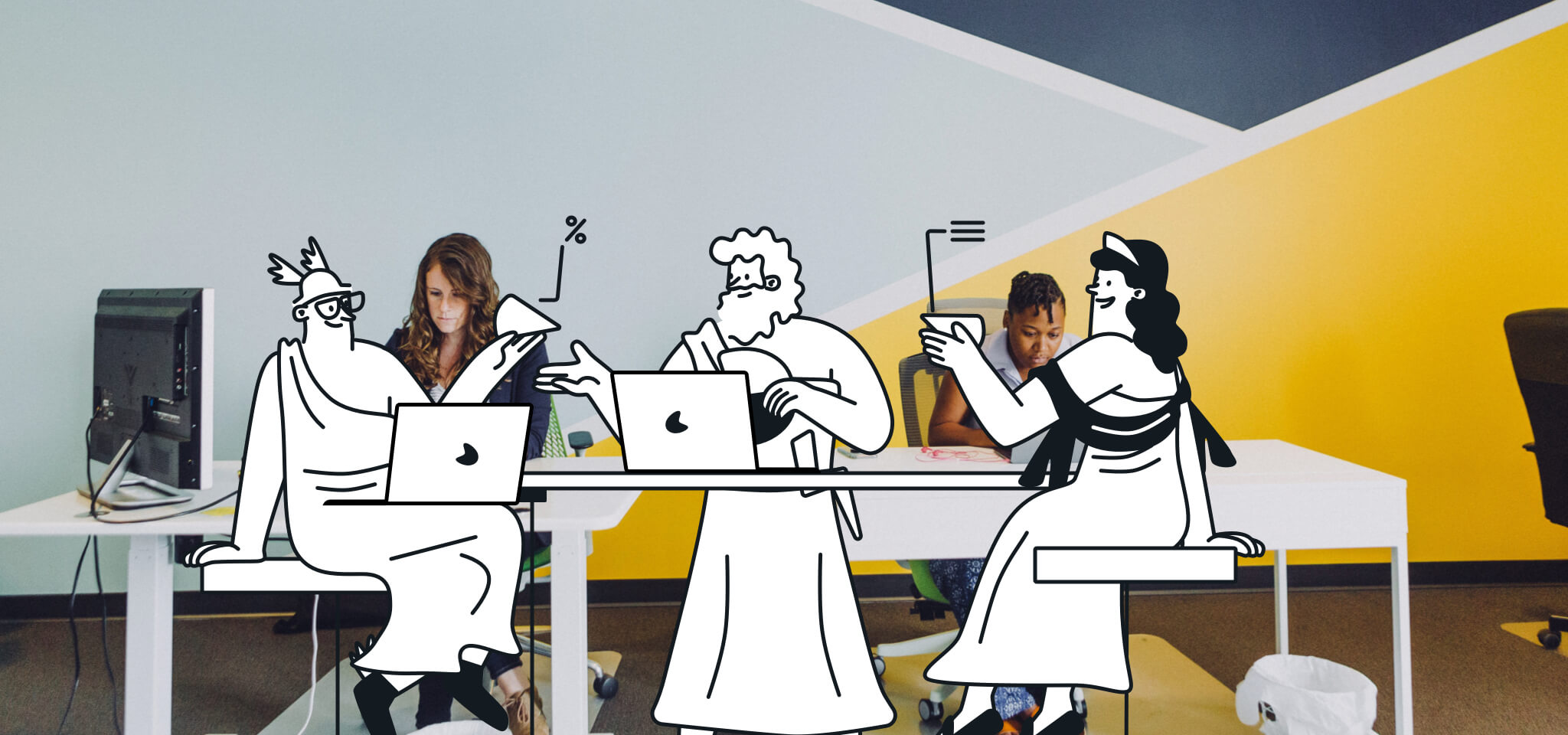
Marketing

When it comes to marketing, you’ve probably lost count of how many times you’ve heard the word “customer.” Or the word “journey.” Heck, you may have even heard the term “mapping” more than a few times. Taken individually, these words may feel a little tiresome. But together? They become a powerful phenomenon known as customer journey mapping.
Customer journey mapping is a form of plotting out your customer’s experience with the typical purchasing process. Read on to find out more about customer journey mapping and how it can help you grow your email strategy. We’ve even included a free downloadable template at the end of this post to help you get started.
Let’s start with the basics. What is a customer journey? The good news is that it’s pretty much what it sounds like:
The customer journey is all of the experiences your customers have with your brand as they (and you) pursue a potential deal. This can start when they first give you a call, look on your website, or initiate another action, and it continues through all of their meetings, deals, and conversations with your brand.
While every customer journey has its differences—length, end result, etc.—there are some common characteristics that we can use to visualize a basic customer experience. These include:
The research step is when a potential customer begins doing research on you and other brands that may suit their needs—and pretty much everyone researches. They’re finding out if you can potentially solve their problems.
This step is when the customer reaches out to you to discuss your brand and gain information that they cannot find just through research. Their requested information may include demonstrations of your product or service, specific questions about how your brand can help their unique situation, and more. During this step, they’re figuring out how good of a fit your brand is for them.
This step is very simple—the customer will want to know what you charge for products and services that benefit them. They want to know: Do you fit into their budget?
The decision-making step may take some time for your customer. They will likely weigh you against different brands to see which one checks most (or all) of their boxes. They want to know that they are entering into a positive, beneficial relationship.
This is the goal of your brand—for your customer to purchase your goods and services and commit to you. This is an exciting and important step, and customers want to know that they are getting what they need.
Every successful brand knows that a customer journey doesn’t just end with a purchase. This step is all yours. Follow up with your customer to guide them smoothly into the beginning of your customer-brand relationship, and make sure you give them the tools to s쳮d.
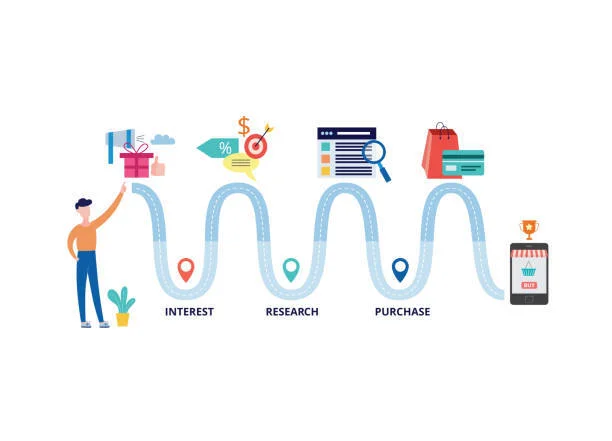
As a formal definition, a customer journey map is a visual step-by-step representation of your customer’s journey with your brand.
These customer journey maps help you clearly visualize each portion of a customer’s journey, and allow you to note details and track progression for each customer throughout the process. Because of this, you’re more prepared to help customers through the sales funnel in real life, and maintain customer loyalty for existing clients.
Before we get to the visuals, let’s review why a customer journey map is so important for email marketing.
Understanding where your customers are in their journeys is incredibly important when it comes to email marketing. Knowing how to assess a customer’s journey helps you intuit when and where to send your emails, and what kind of content to put in them. You can also use your knowledge to segment your customers, anticipate their needs and reach out to them via both proactive and reactive email and customer service.
Additionally, knowing where in their journey your customer is enables you to prepare yourself for their questions and comments, and respond appropriately and helpfully based on what their current “step” is. Let’s elaborate on these benefits:
Outbound marketing tactics (which include traditional methods like billboards and television commercials) can be effective for certain marketing strategies. However, in this day and age, it is increasingly difficult to hold a potential customer’s attention with a one-off ad when they are seeing and hearing hundreds of ads every single day. Additionally, outbound marketing can be expensive, and have an uneven return on investment.
On the flip side, inbound marketing generally includes more organic and engagement-based content (like blogs and social media posts) that help draw your customer in. You aren’t simply throwing an advertisement at them and seeing what sticks—you’re creating content that answers their questions and guides them on their journey.
By using a customer journey map, you can predict what your customers’ future needs and questions will be, and you can use that data to create content that pulls your customers in and makes them feel engaged (and heard) by your brand.
As we’ve discussed, one of the most important reasons to create a customer journey map is to know your primary kinds of customer–or your target audiences, to put it another way. Who is the type of person who buys your product? What need are they solving? Why did they choose you? Once you’ve answered these questions, you can easily segment these customer types for your benefit.
Segmentation allows you to send different emails and other communications to different audience members. This way, you aren’t just sending the same message to everyone and hoping that they respond in the way you want. Instead, you’re proactively and reactively responding to concerns, questions, and praise that each segment may have, and you’re ensuring that you have a stronger grasp of each demographic’s customer journey, and how you can engage with them. And that’s a pretty big bullseye.
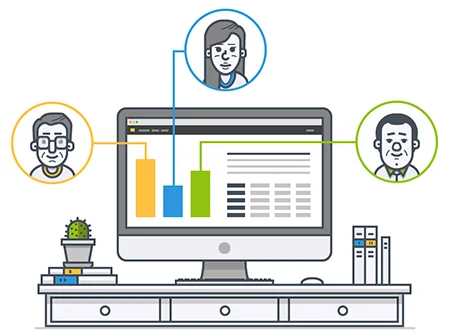
A customer journey map is called a “map” for a reason. It gives you a clear picture of where customers should be going and how they can be satisfied, but it also shows you the pitfalls that can occur when a customer does not get what they need or expect. Planning authentic, effective responses to these potential roadblocks lets you know how to keep customer satisfaction on track, and where an individualized approach may help.
This proactive approach can work wonders when it comes to customer email communications. Is your support team getting more service requests than usual? Is there a period of time where certain functions on your website or online store may be unavailable while you make updates? Send a friendly message ahead of time to let your customers know what’s happening. That way, they know what to expect—and a backlash is avoided.
And it doesn’t stop there—you can use customer journey mapping to identify and help solve any number of problems. When you look at your map, ask yourself: Is there a step in the customer journey where new prospects tend to drop out? Is there a certain action that has prompted existing customers to break off their relationship with your organization? Take a long look (from both the customer’s perspective and your own), and then look again—one-third of consumers will contemplate switching to a competitor after a bad experience. Be motivated to fix problem areas and processes to best service customer needs.
Using both proactive and reactive methods, you can let your customer journey map guide you to create the smoothest path forward for all of your clients, and lead you into successful customer engagement.
It’s probable that, even if your company is small, there are different departments (or simply a couple of people) working on creating the best organization they can from a variety of angles. These angles can include customer support, marketing, sales, and the list goes on. The people behind these different departments and viewpoints probably share a common goal (say, to obtain and maintain a strong customer base), but a smooth, universal process for this goal may be hindered by their varied tasks and approaches.
However, a clear customer journey map can help focus all of your team members on this common goal, and ensure that every department and division is working together to handle different pieces of the map. Marketing may handle inbound and outbound advertising, sales may obtain and guide new customers brought in by marketing, and support may help the new customers that have closed a deal with sales. Together, they can create a detailed, enviable customer experience.
Now that you understand customer journeys, it’s time to learn how to map them. Below, we’ll walk through the components of a customer journey map, and even give you an example to work from. And that’s a wrap!
Below is a visual of a customer journey map example:
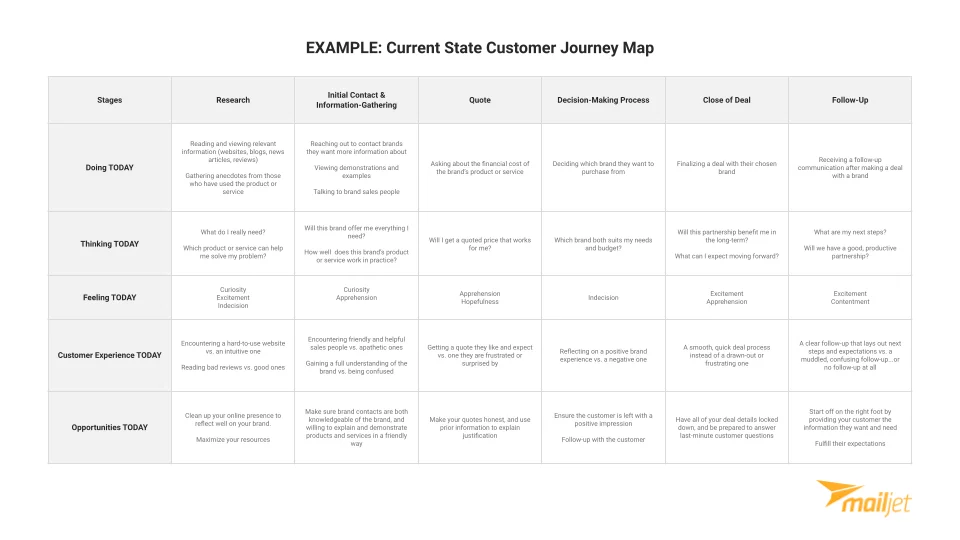
Clearly, uh, visualize this visual for a moment to get a feel for the look of a sample customer journey map template. There are three main types of customer journey maps you can use to visualize—the above is a future state template. Future state maps illustrate what your customers will be doing, thinking, etc. in the future.
Current state maps illustrate what your customers will be doing, thinking, etc., today. An example is below. These steps may be similar or the same as those in a future state map—you simply need to figure out which stages the customer is involved in right now.
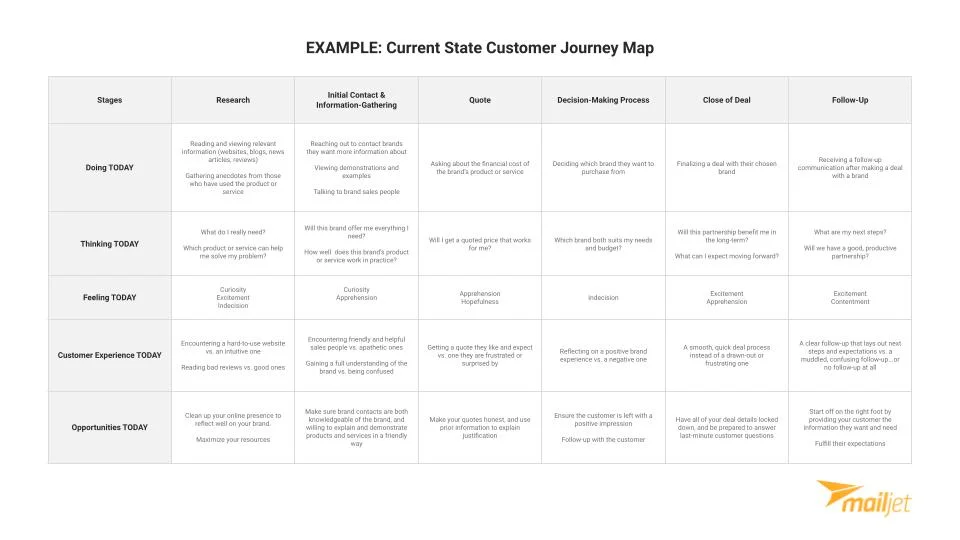
Finally, day in the life maps illustrate everything your customer does in a day, both involving and not involving your company. An example is below.
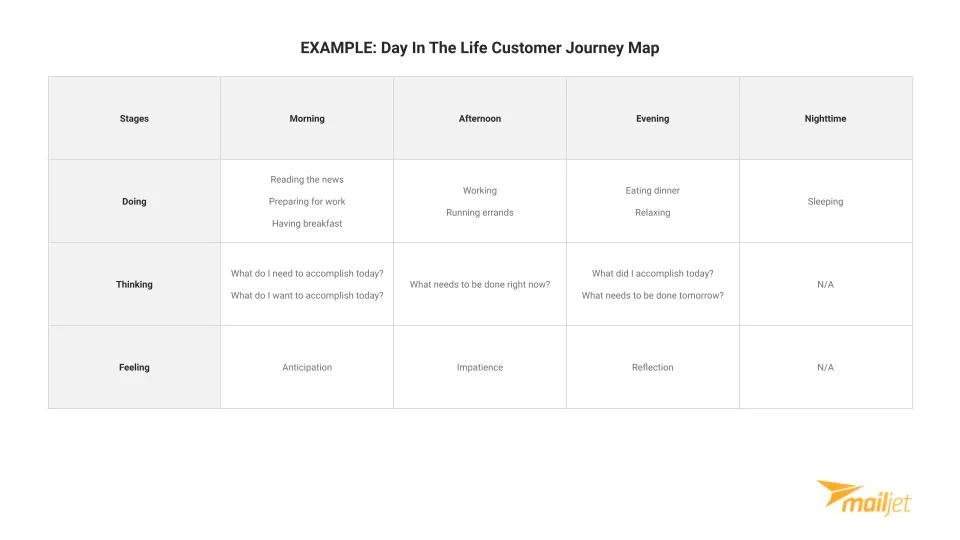
Make sure that you choose the type of map that best suits your objectives. Got it? Let’s break it down for an email strategy…
When creating a customer journey map for your email strategy, you first need to make sure that you set clear objectives for your map. What is the map’s purpose? What do you want to accomplish with it? Know what your goals are. Do you want to convert more customers? (Well, obviously.) Select your goal and let your map grow from it.
Next, define your customers’ personas and goals. Who is the type of person or group that will want your product or service? What do they want to achieve by using your brand? It is highly likely that you will come up with several different customer personas and goals.
Hint: Pick the persona and goal(s) that are most common among your existing customer base. Niche marketing has its place, but understanding the ways of your “everyday” customer will help you pull in more of the type of customer that has made you successful… and help you better visualize and strengthen your existing customer relationships.
After that, define all of your customer touchpoints that connect to email. This includes all sign-up and information forms where your customers enter an email address. It also includes touchpoints such as newsletters, offers, and more—quite literally anything you send or confirm to customers via email. We bet it’s a lot.
And you’re moving along just fine! Once you’ve completed all of that, it’s time to get down to the really deep questions and answers. And no, we’re not talking about the meaning of life. We’re talking about the motivations customers have, actions they take, and obstacles they face while interacting with your email program.
Let’s take a look at some examples.
Why are your customers interacting with your email program? What are their needs and desires? These motivations could be:
Find out why your customers are interested in your email program in the first place.
What actions are your customers taking regarding your email program? What are they regularly doing? These actions could be:
Find out how your customers are interacting with you, and what in your email program makes them act the way they do.
What’s keeping your customers from interacting with you the way you want them to? Some of their obstacles could be:
Figure out what is keeping you from your customers, and find ways to fix the problem.
For example, you might:
After you’ve completed those steps and have completed your map—based on your customer’s journey and behaviors—walk yourself through the customer journey to get a feel for how your typical customer interacts with and sees your brand through your email strategy. When you hit a snag or can’t answer a question, think of solutions that keep the journey on track and prepare you for unexpected potholes. We recommend not taking your customer for a bumpy ride.
Do you know how to define your customer journey map and maximize its impact, but feel that you may need a template to guide you? Have no fear—use our free downloadable template as a helpful model for your own brand.
This map provides space for the journey stages we discussed earlier in this post, and combines them with categories that you can use—having taken the customer journey yourself—to understand how your customers are doing, thinking, and reacting. Using this understanding, you can ably strengthen your email communications and achieve your customer relationship goals.
Who knew customer journeys (and their accompanying maps) could be so insightful? A customer journey map allows you to visualize a customer’s path from research to deal close, and enables you to target your email communications to more effectively facilitate this journey. It’s truly a win-win situation.
Speaking of email communications, Mailjet’s email marketing solutions let you create, personalize, send, and track emails that stand out in a crowd and encourage your recipients to start their own journeys. So we guess that makes this a win-win-win situation?
No matter where your path takes you, we hope that customer journey mapping can make the travel a little bit easier. Once you make it to your destination, you’ll know that you took the perfect route.